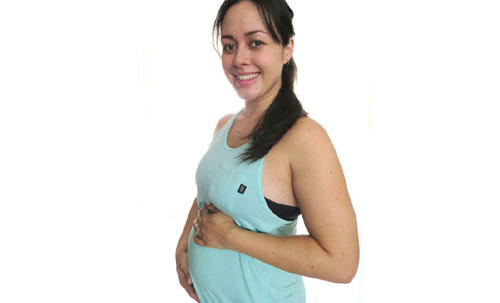 Personal trainer Ange Noy is pregnant with her first child and trying to maintain her fitness level as best as possible while navigating sometimes conflicting advice from her endocrinologist, GP, midwife, family, friends, assorted fitness instructors, online forums and phone apps. When you fall pregnant, how do you keep fit while doing what’s best for baby?
Personal trainer Ange Noy is pregnant with her first child and trying to maintain her fitness level as best as possible while navigating sometimes conflicting advice from her endocrinologist, GP, midwife, family, friends, assorted fitness instructors, online forums and phone apps. When you fall pregnant, how do you keep fit while doing what’s best for baby?
From a theory perspective, there are general do’s and don’ts when it comes to training while pregnant. What I have found interesting is that there is sometimes quite a difference between what I ‘should’ be able to do, versus what my body is actually capable of doing!
One of the most important things to do is follow medical and fitness professional advice, and also to listen to your body.
Here are some of the questions you should ask throughout your pregnancy fitness journey and afterwards.
What exercises should I steer clear of?
Stick to low impact training, avoiding jumping/jarring movements, heavy lifting and excessive twisting movements.
Abdominal crunch movements aren’t recommended, and preferably stop doing exercises that involve lying on your back after the first trimester as the weight of the baby can place pressure on your venae cavae – the large veins which return blood back to your heart. This can cause dizziness for you and reduce blood flow to baby. Core exercises on all fours such as supermans or cat/cow stretch are good alternatives for most women.
Activities that rely on balance and could result in falls such as ice skating and cycling are inadvisable.
If attending group fitness classes, turn up to the session a little early, privately introduce yourself to the instructor and ask them for pregnancy alternatives.
If an exercise doesn’t feel right, stop doing it or find an alternative. While in theory squats and lunges should be fine, I’ve been finding that towards the end of my pregnancy, performing deep squats and lunges feels very uncomfortable so I keep the range of motion small.
I know I shouldn’t overheat, but how hot is too hot?
While spas, saunas, and exercising in hot conditions (especially for long periods of time) are all out, it’s okay if you break a light sweat! This guideline advice is more about keeping your core temperature down as overheating may affect baby’s development. A low-intensity aerobics class in a cool room, waterwalking, swimming, or an outdoor walk are all examples of exercise that should all be fine if you have a relatively good level of fitness.
Tips for keeping cool include exercising in a well ventilated or outdoor space, taking a bottle of water with you to sip while training that has been sitting in the fridge, and having fans or air conditioning around you.
Listen to your body and if you feel yourself overheating, take a break or stop training.
How hard can I train?
Training during pregnancy shouldn’t be about pushing yourself to your limits, but rather keeping yourself active.If you haven’t exercised before, now isn’t the best time to start a new training regime unless it’s something like light walking or swimming. If a doctor has advised you to take up a new exercise programme, it’s best to consult a fitness professional to ensure you are doing activities that are right for you. There is a lot of conflicting and poor advice on the internet, and it’s important to get this right!
While exercising, do the talk test; you should be able to continue to hold a conversation regularly, if not, it’s time to take a break or stop training.
What exercises can I do post-pregnancy?
In at least the first six weeks after you have given birth, your key focus should be on bubs rather than exercise. However, if you’re going stir-crazy at home and you want to do something active, the best things you can do is practice pelvic floor/kegels exercises and go for an easy, short walk to get some light cardio activity happening. If you experience bleeding, dizziness or any other adverse effects, stop the activity and consult your GP before continuing training.
Following this transitional period, listen to your body, your doctor and a trainer, and ease yourself back into a fitness routine starting with light exercise. If you have had a C-section, allow yourself even more time to build up your exercise practice; remember that you have had abdominal surgery and it will take longer than six weeks to rehabilitate the abdominal muscles – sometimes up to a year, so exercising under the guidance of a fitness professional would be the best option for you to help ensure you go about it properly.
Due to the belly expanding during pregnancy, some women’s abdominal muscles/connective tissue can separate down the front (the line in the centre of your ‘six pack’ muscles) which can change the appearance of this area post-pregnancy. If you have experienced abdominal separation, or diastasis recti, it’s a good idea to get a professional to help you out with rehabilitation as performing activities such as heavy weight lifting or ab crunches may worsen the issue permanently. If treated correctly, the symptoms of diastasis recti can heal or at least be reduced.
Are you pregnant? What are you doing to maintain your fitness? What difficulties have you run into?
Disclaimer: Remember, if you are pregnant, it’s important to be cleared by a GP or another medical professional for exercise. Do not start new exercise programmes without checking with them first. Always listen to your body during training and stop if you experience dizziness, bleeding, breathlessness, contractions or any other signs of labour.

